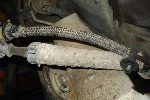MiWiAu
Active Member
- Joined
- August 23, 2016
- Messages
- 69
- Reaction score
- 1
- City, State
- Milwaukee
- Year, Model & Trim Level
- 2013 Explorer Sport
Does anyone have any tips or a write-up on removing the CAC for cleaning? I'm in the process of installing an OCC, and I've stalled out trying to remove the intercooler. I have all the fasteners and hose connections removed, but I can't seem to persuade it out.
I still have the fan shroud installed. Does this have to come off, or is it possible to somehow remove it from the front? Any way of cleaning the CAC with it still installed in the vehicle?? I'm really hoping I don't have to disconnect and remove the entire radiator to get out the CAC.
Thanks!
I still have the fan shroud installed. Does this have to come off, or is it possible to somehow remove it from the front? Any way of cleaning the CAC with it still installed in the vehicle?? I'm really hoping I don't have to disconnect and remove the entire radiator to get out the CAC.
Thanks!










